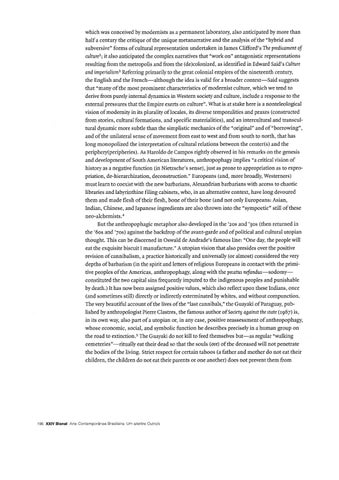which was conceived by modernists as a permanent laboratory, also anticipated by more than half a century the critique ofthe unique metanarrative and the analysis ofthe "hybrid and subversive" forms of cultural representation undertaken in James Clifford's The predícament of culture2 ; it also anticipated the complex narratives that "work on" antagonistic representations resulting from the metropolis and from the (de)colonized, as identified in Edward Said's Culture and ímperíalísm 3 Referring primarily to the great colonial empires of the nineteenth century, the English and the French-although the idea is valid for a broader context-Said suggests that "many of the most prominent characteristics of modernist culture, which we tend to derive from purely internal dynamics in Western society and culture, include a response to the external pressures that the Empire exerts on culture". What is at stake here is a nonteleological vision ofmodernity in its plurality oflocales, its diverse temporalities and praxes (constructed from stories, cultural formations, and specific materialities), and an intercultural and transcultural dynamic more subtle than the simplistic mechanics ofthe "original" and of"borrowing", and of the unilateral sense of movement from east to west and from south to north, that has long monopolized the interpretation of cultural relations between the center(s) and the periphery(peripheries). As Haroldo de Campos rightly observed in his remarks on the genesis and development ofSouth American literatures, anthropophagy implies "a criticaI vision of history as a negative function (in Nietzsche's sense), just as prone to appropriation as to expropriation, de-hierarchization, deconstruction." Europeans (and, more broadly, Westerners) must learn to coexist with the new barbarians, Alexandrian barbarians with access to chaotic libraries and labyrinthine filing cabinets, who, in an alternative context, have long devoured them and made flesh oftheir flesh, bone oftheir bone (and not only Europeans: Asian, Indian, Chinese, and Japanese ingredients are also thrown into the "sympoetic" still ofthese neo-alchemists. 4 But the anthropophagic metaphor also developed in the '20S and '30S (then returned in the '60S and '70S) against the backdrop ofthe avant-garde and ofpolitical and cultural utopian thought. This can be discerned in Oswald de Andrade's famous line: "One day, the people will eat the exquisite biscuit I manufacture." A utopian vision that also presides over the positive revision of cannibalism, a practice historically and universally (or almost) considered the very depths ofbarbarism (in the spirit and letters of religious Europeans in contact with the primitive peoples of the Americas, anthropophagy, along with the pecatus nefandus-sodomyconstituted the two capital sins frequently imputed to the indigenous peoples and punishable by death.) It has now been assigned positive values, which also reflect upon these Indians, once (and sometimes still) directly or indirectly exterminated by whites, and without compunction. The very beautiful account ofthe lives ofthe "last cannibals," the Guayaki ofParaguay, published by anthropologist Pierre Clastres, the famous author ofSocíety agaínst the state (1967) is, in its own way, also part of a utopian or, in any case, positive reassessment of anthropophagy, whose economic, social, and symbolic function he describes precisely in a human group on the road to extinction. 5 The Guayaki do not kill to feed themselves but-as regular "walking cemeteries"-ritually eat their dead so that the souls (ove) ofthe deceased will not penetrate the bodies of the living. Strict respect for certain taboos (a father and mother do not eat their children, the children do not eat their parents or one another) does not prevent them from
196 XXIV Bienal Arte Contemporânea Brasileira: Um e/entre Outro/s
